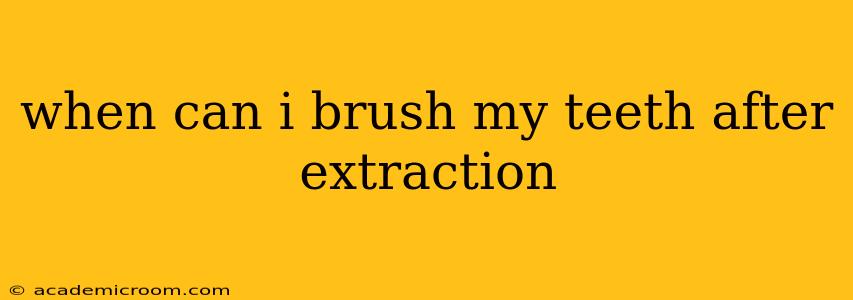Tooth extraction, while a common procedure, leaves your mouth vulnerable. Knowing when and how to brush your teeth afterward is crucial for preventing infection and promoting healing. This guide will answer all your questions about oral hygiene post-extraction.
How Soon Can I Brush My Teeth After a Tooth Extraction?
The short answer is: wait at least 24 hours. Your dentist or oral surgeon will likely give you specific instructions, but waiting a full day allows the blood clot to form properly at the extraction site. This clot is essential for healing and preventing a painful, potentially serious complication called dry socket.
What Happens If I Brush Too Soon?
Brushing too soon after an extraction can dislodge the blood clot, exposing the underlying bone and nerve endings. This leads to a dry socket, characterized by intense pain, bad breath, and a visible empty socket. Dry socket requires professional attention and can significantly delay healing.
What Kind of Brush Should I Use After Extraction?
Once the 24-hour waiting period is over, use a soft-bristled toothbrush. Avoid harsh scrubbing, especially near the extraction site. Gentle circular motions are best. Focus on cleaning the rest of your mouth thoroughly to prevent the buildup of bacteria that could spread to the extraction site.
Can I Use Mouthwash After Tooth Extraction?
The use of mouthwash after extraction is a bit nuanced. You should avoid using mouthwash during the initial 24-hour period, as it could also dislodge the blood clot. After that time, you can use a saltwater rinse (1/2 to 3/4 teaspoon of salt dissolved in 8 ounces of warm water) several times a day. Saltwater helps to clean the area gently and promotes healing. Avoid alcohol-based mouthwashes as they can irritate the sensitive area. Your dentist may recommend a specific mouthwash if needed.
How Should I Brush Near the Extraction Site?
When you begin brushing again, be incredibly gentle near the extraction site. Avoid brushing directly on the socket itself. Focus on the surrounding teeth, ensuring thorough cleaning without disturbing the healing process.
What Are the Signs of a Dry Socket?
Recognizing the signs of a dry socket is crucial for timely treatment. These signs include:
- Severe, throbbing pain that starts 2-3 days after the extraction
- Bad breath
- A visible empty socket
- Delayed healing
If you experience any of these symptoms, contact your dentist or oral surgeon immediately.
Can I Use an Electric Toothbrush After Extraction?
While an electric toothbrush can be convenient, it's best to stick with a soft-bristled manual toothbrush for the first week or so after an extraction. The gentler motion of a manual brush minimizes the risk of dislodging the clot or irritating the healing tissue. Once the area has healed significantly, you can resume using your electric toothbrush, but still use a low setting and avoid the extraction site directly.
When Can I Resume Normal Oral Hygiene?
You can usually resume your normal oral hygiene routine, including flossing, once the extraction site has healed sufficiently, typically within a week or two. Your dentist will provide more specific guidance based on your individual healing progress.
Remember, post-extraction care is critical. Following these guidelines and adhering to your dentist's instructions will ensure a smooth recovery and healthy mouth. Always consult your dentist or oral surgeon if you have any concerns or experience any unusual symptoms.
